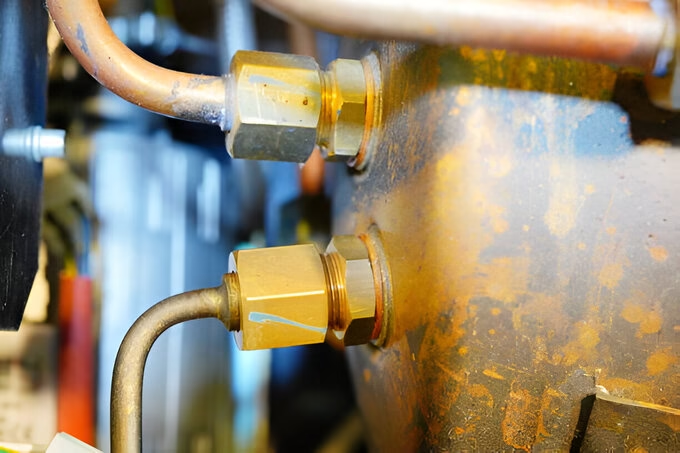How to Unclog AC Drain Line: Easy Step-by-Step Guide

How to Unclog AC Drain Line: Easy Step-by-Step Guide A clogged AC drain line is a common problem in homes that can lead to water damage, less effective cooling, and musty smells. It can save you time, money, and stress to know how to Unclog AC drain line. If you want to fix the problem and keep it from happening again, this complete and simple guide will show you how. What Is an AC Drain Line? The AC drain line, also called the condensate drain line, is a pipe that gets rid of the extra water that your air conditioner’s evaporator coil makes. Your air conditioner does more than cool your home; it also removes moisture from the air. This water builds up in a drip pan and drains away through the condensation line. Why Does the AC Drain Line Get Clogged? Dust, algae, mold, and other things can get stuck in the drain line over time, stopping the flow of water. Some common reasons are: Do not do regular cleaning. High humidity levels Dirty air filters Infrequent use of the AC system If this line gets clogged, water will back up into the unit and could overflow, which could damage your house. Signs Your AC Drain Line Is Clogged You need to know what a clog looks like before you can learn how to Unclog AC drain line. Keep an eye out for: There is a pool of water near the central AC unit. Musty or moldy odors The AC unit isn’t cooling right. High indoor humidity levels The AC is turning off without warning. Tools and Supplies You’ll Need The following tools will help you clear the blockage: Wet/dry vacuum Funnel or flexible tubing Distilled vinegar or bleach Pipe brush or stiff wire Screwdriver (to open panels) Bucket and towels Step-by-Step Guide: How to Unclog AC Drain Line Step 1: Turn Off the Power First, safety! To keep your family safe, always turn off the power to your HVAC system at the thermostat and breaker box. Step 2: Locate the Drain Line You can find the AC drain line near the outdoor condenser unit or inside near the air handler. It is usually a white or PVC pipe. Step 3: Inspect the Drain Line Check for clear signs of clogging or water that won’t go away. To check for buildup, take off the cap from the T-shaped vent that leads to the drain line. Step 4: Use a Wet/Dry Vacuum Put the vacuum on the end of the drain line that is outside your house. Cover the hole with duct tape or a towel, and then run the vacuum for two to three minutes. The clog should be gone with this pressure. Step 5: Flush the Drain Line Mix one cup of warm water with one cup of pure white vinegar. Pour this into the drain line through the entry point. Mold and bacteria will die after 30 minutes. You could also use a weak bleach solution (1:1 with water) if the maker lets you. Step 6: Rinse with Water Once the vinegar or bleach has done its job, use a scoop or pipe to flush the line with clean water to make sure it’s dry. Step 7: Reassemble and Turn the Power Back On When the drain line is dry and clean, put the access cap back on and turn the power back on. Preventing Future AC Drain Line Clogs Follow these repair tips to keep your AC system working well: Every month, flush the drain line with vinegar. Every 1 to 3 months, change the air filters. Schedule HVAC checks once a year. Clean up the area around the inner unit. Put in a float switch to find clogs early. To save energy, set your setting to 24–26°C (75–78°F), which is the best temperature for air conditioning. This helps lower the heat and stress on your system, which makes clogs less likely. Real-World Example A homeowner in Florida said that even though the AC was on all the time, there was a musty smell and high humidity. The expert looked and saw that algae had plugged the AC drain line. A quick vacuum and vinegar flush solved the problem and made the house comfortable again. Pros and Cons of DIY Drain Line Cleaning Pros: Spends less on service calls Simple tools make it easy to do Stops water damage Cons: Might not clear out big clogs Possible damage to the machine if not done right Fears for safety without turning off the power Conclusion If you know how to Unclog AC drain line, you can avoid expensive fixes and water damage. You can keep your system going well with just a few simple tools and regular upkeep. If you try to fix the problem yourself and it doesn’t work, don’t be afraid to call a professional HVAC expert. FAQs What causes AC drain lines to clog? Inside the pipe, dirt, mold, algae, and other things get stuck, stopping the flow of water and leading to floods. Can I use bleach to unclog my AC drain line? Of course, you can use a 1:1 bleach and water mix, but first, check your AC instructions to make sure it’s safe. How often should I clean my AC drain line? The AC pipeline should be cleaned once a month, more often in the summer. When should I call a professional? If you try to fix the problem yourself and fail, or if you keep having clogs, water leaks, or the system stops working, you should call a qualified HVAC expert. External Reference Energy.gov HVAC Maintenance Tips